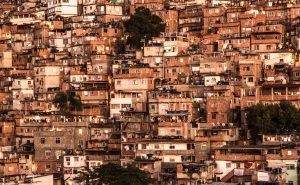74 Latin America and the Caribbean (LACAR): Urban Geography I – Rural-to-Urban Migration in Brazil
In Latin America, rural-to-urban migration has been a major demographic motor over the last few decades. This geographic movement of people caused considerable urban change. The Brazilian favela or, in general terms, the shantytown, is a consequence of that migratory surge to cities.
In 1950, Latin America’s population was just 25% urban. By 2015, the region was 75% urban. Consider the push factors (forces that caused people to leave rural areas) and pull factors (forces that cause people to move to cities) behind this dramatic reshuffling of Latin America’s population.
Migration in Brazil, as with human migration anywhere on the planet, is prompted by push and by pull factors. Push factors compel people to leave (pushed away) where they are living, for that location has become hazardous due to a natural disaster (e.g., hurricane) or a societal constraint (e.g., political oppression). In Latin America the major push factor was unemployment. In the mid-20th century, the region experienced the Green Revolution – the introduction of modern farming technologies like advanced machinery, high-yield hybrid crops, and chemical pesticides and fertilizers. This was beneficial, because many Latin American countries dramatically increased their agricultural output. The downside, though, was a dramatic reduction in the need for farm labor. Sharecroppers and plantation workers lost their livelihoods, and headed to cities to look for work. Even those small-scale Latin American farmers who owned their own land suffered. The Green Revolution increased agricultural yields, but it also increased the cost of farming. Thousands of small-scale farmers could no longer compete with larger corporate farms, and many of them were forced to sell their land and move to the city. At the same time, new technologies were introduced in mining and logging that eliminated a lot of the remaining rural jobs in the region.
In contrast, pull factors bring people toward (pull to) a new destination, for that location offers or seems to offer a better living situation. Most, but not all, of the pull factors were economic in nature. People moved to cities in hopes of higher wages and more employment opportunities. Cities offered greater chances for upward social mobility – in rural areas, people who are born poor tend to remain poor. In urban areas, there was a chance to climb the socioeconomic ladder. Cities also tend to feature higher-quality education, health care, and other public services. Finally, many migrated to cities because of the perceived superiority of urban lifestyles. This is known as the “city lights” phenomenon. As wonderful as rural areas can be, they generally don’t offer the same kind of excitement as a place like Mexico City or Rio de Janeiro.
These rural-to-urban push and pull factors are not unique to Latin America. They are part of the demographic transition that all countries eventually experience. The same push and pull factors were present a century or two ago in North America and Europe. Luckily for people in those regions, there were millions of manufacturing jobs awaiting them when they arrived in the cities.
Latin America has not been so fortunate. As people began crowding into Latin American cities in the 1970s, they overwhelmed the urban infrastructure. The cities simply could not provide adequate housing, utilities, schools, transportation, and employment for this crush of migrants. That forced many of these new urban dwellers into squatter settlements – illegal, informal slums where people “squatted” on land they did not own, and constructed homes out of salvaged materials.
A final distinct characteristic of rural-to-urban migration in Latin America has been the tendency to target primate cities. A qualitative definition of a primate city is a large city dominates the rest of the country demographically, culturally, politically, and economically. Recall that in Chapter 54, we considered primate cities in Europe. Since Brazil does not meet all the criteria for developing a primate city, we do not find all the rural-to-urban migrants in a single metropolitan area there.
Rural-to-urban migration in Brazil occurs due to these push and pull factors. Certainly, sometimes there are both positive and negative elements of rural life. Those who are large landowners in rural Brazil typically do quite well economically. However, landless peasants and anyone doing wage labor in rural Brazil may live in relatively poverty. Drought or other weather factors may contribute to economic difficulties. When these rural conditions are severe, this may force rural-to-urban migration, thus placing these human flows in the push category.
Frequently though, the pull of the city is the major portion of motivation for the countryside dweller to move to the city. Principally the city offers job opportunities that if secured would multiply a migrant’s earnings substantially. Again the “bright lights” of multiple attractions and features in cities like Rio de Janeiro may uproot rural residents and draw them to urban life.
Geographers often are interested in studying migration patterns. Pull migration reveals a fascinating comparison of different geographic locations, where the preferred or better location secures the resident.
Naturally then, geographers have studied the patterns of rural-to-urban migration in Brazil. As in much of Latin America, these migration flows in Brazil have transformed the country from a rural society to an urban land. In comparison to the migration experiences of North American and European countries, this transformation has been distinctly more rapid. In 1940, Brazil held only about 30% of its citizens in urban areas. Less than eight decades later, in 2018 Brazil was 86.6% urbanized. In contrast, the USA had 30% urban levels in 1885, but was at 82.2% in 2018. American urbanization proceeded at a slower pace than in Brazil, whereas Brazil actually is more urban than the United States is now.
In addition, geographers have been interested in the logic and motivations of potential migrants in Brazil. One interesting approach in these queries is the mathematical logic of expected return.
A simple way of examining the concept of expected return is the Powerball lottery. The odds of winning the jackpot in Powerball are 1 in 292,201,338, but for simplicity, let’s call that one in three hundred million. A Powerball ticket costs $2. Should you buy a Powerball ticket? That depends on the size of the jackpot to be won. Let’s say that the jackpot is $150 million.
Jackpot X Odds = Expected Return
$150 million X (1 / 300 million) = $0.50.
In that case, your expected return is fifty cents, but you paid $2 for the ticket. Bad strategy, paying for less than you mathematically expect to win.
What if the jackpot is $750 million? Use the same formula.
$750 million X (1 / 300 million) = $2.50.
In this scenario, your expected return is $2.50, but you paid only $2 for the ticket. Mathematically, this is a good strategy for your expected return is more than your cost.
We can consider rural-to-urban migration in Brazil in the same fashion. What would be paid or given up if trading rural life for urban life? Many things, but we are talking about income to begin. So, the migrant is giving up known patterns of rural income. What is to be gained? Urban income. How much urban income? That is unknown, but estimated. The potential migrant typically does not have a job lined up in the big city, but would be practicing speculative migration by moving to the city in the hopes of getting a job. What are the chances of getting employment in the urban area? That too is unsure, but estimated.
So what is our formula?
Estimated urban income X the estimated odds of that happening = the expected return.
Compare that estimated expected return with the known rural income. If the estimated expected return exceeds by more than a little the known rural income, then the rural dweller should move to the city. If not, then stay in the countryside.
For instance, if the average monthly urban wage1 in Minas Gerais state of Brazil is R$2138 (where R$ the Brazilian currency, the real), should the rural worker move to the city? What is the rural income? What are the estimated odds of getting the urban income? Let’s say that the odds are fifty/fifty or one out of two chances. Let’s say that rural worker is making the minimum wage there at R$876 monthly. Do the math.
Estimated urban income X the estimated odds of that happening = the expected return.
R$2138 X 0.50 = R$1069
Since R$1069 is more than the known income of R$876, the migration to the city should happen. It is mathematically logical.
Throughout Latin America, millions of people have undertaken this rural-to-urban migration. Generally, studies have shown that this migration is mathematically logical. In a sense this is good news. Geographers like it when people behave in geographically rational ways.
However, there are complications.
When purchasing a Powerball ticket, it may be mathematically logical if the jackpot is sizeable enough. However, there is no guarantee of winning the jackpot! In fact, the overwhelming odds are that any given ticket purchaser will win $0.00. For the casual purchaser of a lottery ticket or two, this is not a big deal, but can be spent to create a little bit of fun anticipation.
When choosing to migrate to a city in Brazil, the person leaving the countryside is not guaranteed a job, for that is the nature of speculative migration. In fact, often the migrant fails to secure a regular job, by subsists on irregular, informal income. The move to the city and the challenge of trying to secure unpromised income may be mathematically sound, but is not casual or just a little bit of fun.

The cities of Brazil, in particular the giants of Sao Paulo and Rio de Janeiro, faced a number of problems due to the flood of migrants from the countryside over the past few decades. The singular urban problem is the favela or shantytown. The consequence of thousands, even millions, of rural folk arriving in cities, but having very little money and no proof of guaranteed wage income, necessarily generate a vast host of DIY shelters/shacks/homes that are jammed next to each other or even in stacks upon each other. The Brazilian favela features primitive to simple housing, little or no municipal services like water, paths more than streets, and high rates of crime. Because unclaimed land or at least places of unclear ownership usually are on the edges or peripheries of the urban areas, favelas rapidly grow in size and number in those outer sectors of the urban land. Unused hillsides become meccas for the vertical favelas, popping upward in stacked varieties along the hills’ slopes.

The Latin America city has been modeled by Ernest Griffin and Larry Ford, originally in 1980 and modified as these cities evolved over time. An interactive diagram of this model can be seen here — https://www.thinglink.com/scene/741386144226213889.
In a sense like the purchaser of a Powerball ticket, seeking a gigantic jackpot, the rural-to-urban migrant in Brazil apparently reacts mathematically to perceived opportunities in the metropolitan realm. However, just as the Powerball ticket isn’t guaranteed winnings, the migrant isn’t assured of a good job, but often lives an economically precarious life, frequently by lodging in the favelas on the edges of the city.
Did You Know?
Let’s acknowledge that the scenarios presented above are intentionally simplified. The expected return of winning the lottery are complicated by a number of issues. Does the winner accept an annuity over thirty years or take a lesser lump sum payment now? How much of the winnings will be handed over through federal and state taxes? Including these factors will create a more complicated equation than that noted above.
Similarly, the choice of moving or not moving to the Brazilian city is not only predicated on average income. What are tax differences? How do cost of living levels vary between rural and urban settings? Indeed, there are other factors that likewise create a more complicated formula than that noted above.
However, the fundamental notion of economic comparison is the basis for logically determining whether or not to purchase a Powerball ticket and often for deciding whether or not to move to the city.
Cited and additional bibliography:
1 De Freitas Barbosa, Alexandre, Marina Barbosa E Silva, Paulo Candia, Veiga Murilo, and Alves Zacareli. 2016. “Series 1, Report 5 Living Wage Report Rural Brazil Minas Gerais South/Southwestern Region Coffee Growing Industry.” https://www.isealalliance.org/sites/default/files/resource/2017-12/Living_Wage_Benchmark_Report_Brazil.pdf.
“Brazil – Ongoing Domestic Migration | Britannica.” 2019. In Encyclopædia Britannica. https://www.britannica.com/place/Brazil/Ongoing-domestic-migration.
Chensiyuan. 2014. Rocinha Favela Rio de Janeiro Panorama Brazil 2014. https://en.wikipedia.org/wiki/Favela#/media/File:1_rocinha_panorama_2014.jpg. Creative Commons Attribution-Share Alike 4.0 International.
Jones, Chris. 2014. Favela. https://tinyurl.com/riofavela. Attribution-NonCommercial 2.0 Generic (CC BY-NC 2.0).
Stockton, Nick. 2016. “The Fascinating Math Behind Why You Won’t Win Powerball.” Wired. January 12, 2016. https://www.wired.com/2016/01/the-fascinating-math-behind-why-you-wont-win-powerball/.





